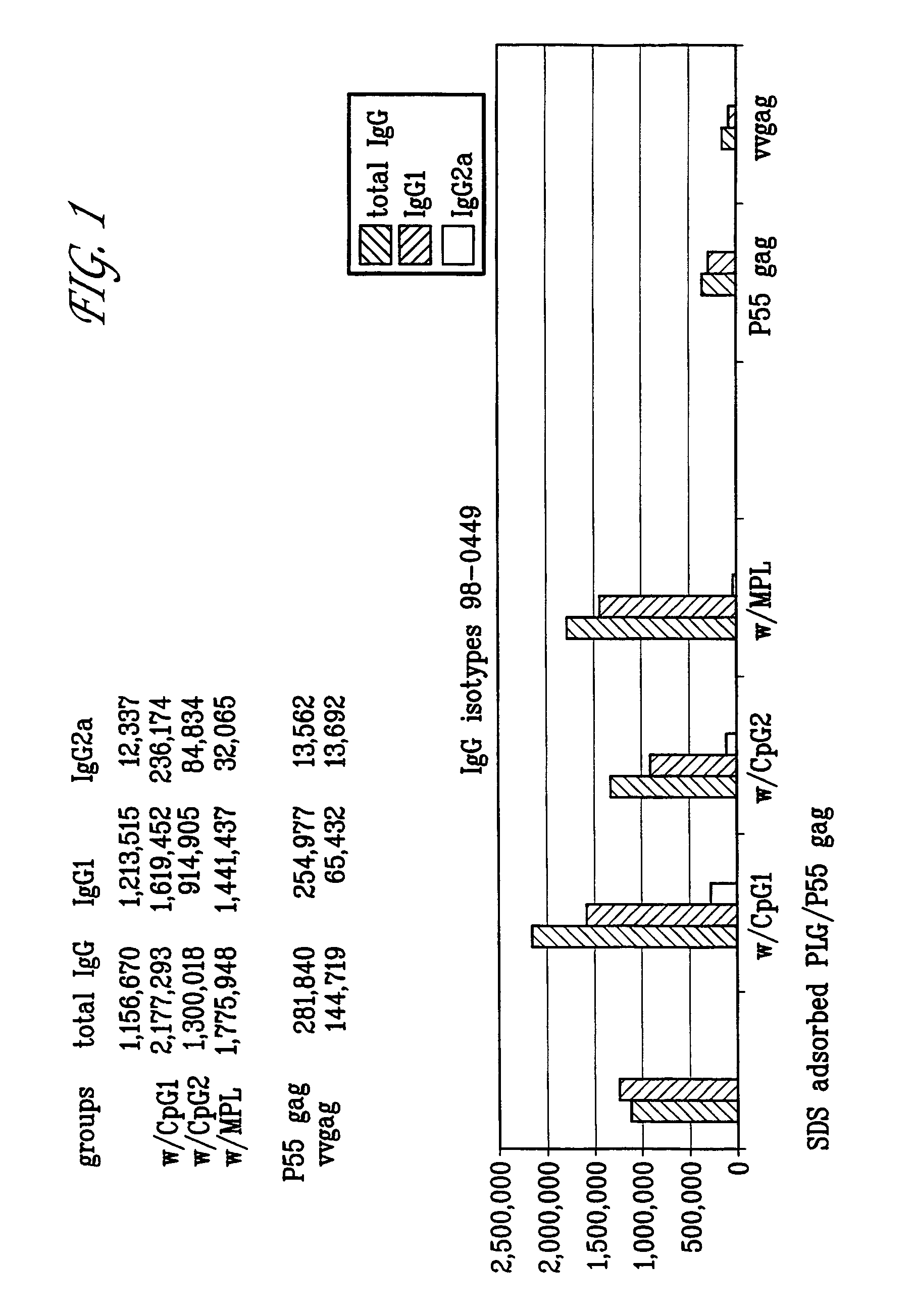Microemulsions with adsorbed macromolecules and microparticles
a technology of microemulsions and macromolecules, applied in the field of pharmaceutical compositions, can solve the problems of difficult or impossible to adsorb charged or bulky biologically active agents to the surface of microparticles, and the presently used adjuvants do not adequately induce th1 cell responses, so as to improve the adsorption of viral antigens and improve immune responses
- Summary
- Abstract
- Description
- Claims
- Application Information
AI Technical Summary
Benefits of technology
Problems solved by technology
Method used
Image
Examples
example 1
Preparation of Blank Microparticles Using PVA as an Emulsion Stabilizer
[0192]Blank microparticles (e.g., without adsorbed or entrapped macromolecules) were made using polyvinyl alcohol (PVA) as follows. Solutions used:
[0193](1) 6% RG 504 PLG (Boehringer Ingelheim) in dichloromethane.
[0194](2) 10% polyvinyl alcohol (PVA) (ICN) in water.
[0195]In particular, the microparticles were made by combining 10 ml of polymer solution with 1.0 ml of distilled water and homogenizing for 3 minutes using an Omni benchtop homogenizer with a 10 mm probe at 10K rpm to form a water / oil (w / o) emulsion. The w / o emulsion was added to 40 ml of the 10% PVA solution, and homogenized for 3 minutes, to form a water / oil / water (w / o / w) emulsion. The w / o / w emulsion was left stirring overnight for solvent evaporation, forming microparticles. The formed microparticles were washed with water by centrifugation 4 times, and lyophilized. The microparticles were then sized in a Malvern Master sizer for future use.
example 2
Preparation of Blank Microparticles Using Ctab
[0196]Blank microparticles were produced using CTAB as follows. Solutions used:
[0197](1) 4% RG 504 PLG (Boehringer Ingelheim) in dimethyl chloride.
[0198](2) 0.5% CTAB (Sigma Chemical Co., St. Louis, Mo.) in water.
[0199]In particular, the microparticles were made by combining 12.5 ml of polymer solution with 1.25 ml of distilled water and homogenizing for 3 minutes using an Omni benchtop homogenizer with a 10 mm probe at 10K rpm to form a w / o emulsion. The w / o emulsion was added to 50 ml of the 0.5% CTAB solution and homogenized for 3 minutes to form a w / o / w emulsion. The w / o / w emulsion was left stirring overnight for solvent evaporation, forming microparticles. The formed microparticles were then filtered through a 38μ mesh, washed with water by centrifugation 4 times, and lyophilized. The microparticles were then sized in a Malvern Master sizer for future use.
example 3
Preparation of Blank Microparticles Using SDS
[0200]Blank microparticles were produced using SDS as follows. Solutions used:
[0201](1) 6% RG 504 PLG (Boehringer Ingelheim) in dimethyl chloride.
[0202](2) 1% SDS (Sigma Chemical Co., St. Louis, Mo.) in water.
[0203]In particular, the microparticles were made by combining 12.5 ml of polymer solution with 50 ml of the SDS solution and homogenizing for 3 minutes using an Omni benchtop homogenizer with a 10 mm probe at 10K rpm. The emulsion was left stirring overnight for solvent evaporation. The formed microparticles were filtered through a 38μ mesh, washed with water by centrifugation 4 times, and lyophilized for future use. The microparticles were then sized in a Malvern Master sizer for future use.
PUM
| Property | Measurement | Unit |
|---|---|---|
| diameter | aaaaa | aaaaa |
| diameter | aaaaa | aaaaa |
| diameter | aaaaa | aaaaa |
Abstract
Description
Claims
Application Information
 Login to View More
Login to View More - R&D
- Intellectual Property
- Life Sciences
- Materials
- Tech Scout
- Unparalleled Data Quality
- Higher Quality Content
- 60% Fewer Hallucinations
Browse by: Latest US Patents, China's latest patents, Technical Efficacy Thesaurus, Application Domain, Technology Topic, Popular Technical Reports.
© 2025 PatSnap. All rights reserved.Legal|Privacy policy|Modern Slavery Act Transparency Statement|Sitemap|About US| Contact US: help@patsnap.com



